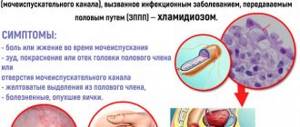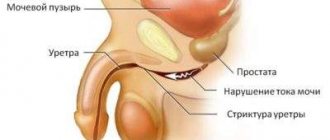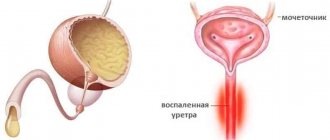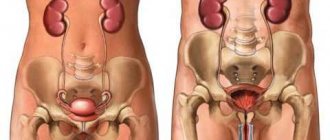We would like to discuss with you the 2 most common diseases of the urinary system - urethritis and cystitis. After reading this article, you will be able to suspect the presence of these diseases in yourself and your loved ones, learn about modern diagnostic methods that allow you to distinguish these conditions from other similar pathological processes, learn about modern approaches to the treatment of urethritis and cystitis, and be able to understand the reason for the failure of previous therapy and identify specific predisposing factors for the development of these two diseases.
Why does cystitis and urethritis develop?
Everything is quite simple - bacteria enter the urethra and begin to multiply on the mucous membrane of the organ. If a person is not treated, the infection goes up and ends up in the bladder. This is how cystitis begins - if you do not act on it, then the next complication of one infection may be pyelonephritis.
The situation is dangerous. One organ - the urethra - cannot become a blocker of infection. It will follow an upward path, and such a disease is more difficult to treat.
Bacteria enter the urinary canal:
- Due to concomitant gynecological diseases;
- Due to urolithiasis;
- Due to existing infections;
- After surgery.
Sometimes urethritis can even cause violent sexual intercourse. Thus, quite often doctors detect urethritis in women with an intense sex life; hyperstimulation of the perineal organs can be fraught with inflammation of the urethra.
An important point: a healthy person with a good immune response can cope with pathogens in the urethra - no medications or other medical procedures are needed. But a weakened body creates conditions for the proliferation of pathogenic bacteria.
Causes of urethritis
Urethritis develops as a result of infection of the body by pathogenic flora, sexually transmitted pathogens, urolithiasis (stones moving along the canal damage the mucous membrane), and the growth of cancerous tumors.
The disease progresses against the background of allergies and as a result of injury (during cystoscopy, catheterization and more), accompanied by a narrowing of the urethra.
An additional risk factor is improper drinking regimen, accompanied by irregular urination, accumulation of bacteria in the canal, and irritation of the mucous membrane with high concentrations of urine.
Risk factors characteristic of diseases include:
- Failure to comply with cleanliness and hygiene standards.
- Unprotected sex with infected people.
- Sharing personal hygiene items.
- Anatomical disorders related to the structure of the pelvis.
- Reduced efficiency of the immune system (for example, due to physical fatigue, stress overload, depression, alcohol abuse, unbalanced diet).
- Vaginal dysbiosis, vaginitis (in women).
- Chronic infectious foci affecting various organs and systems of the body.
- Leading a sedentary lifestyle, as a result of which blood circulation in the pelvis deteriorates.
Symptoms of urethritis
There are no obvious symptoms for this disease. During the incubation period, urethritis may not indicate itself at all. In half of all cases, the disease is asymptomatic.
If urethritis manifests itself, then the following:
- Discomfort during urination;
- Possibly blood in urine;
- Discharge from the urethra;
- Morning sensation as if the urinary canal is stuck together.
It is not necessary that all symptoms will manifest themselves immediately and/or be severe enough. But if they appear, there is a reason to check a possible diagnosis.
Causes of diseases
The occurrence of both diseases is caused by the influence of bacteria or the influence of external factors on the urethra and bladder. The main reasons are:
- Eating disorders associated with the abuse of alcoholic beverages, carbonated water and coffee.
- Failure to comply with personal hygiene requirements. You should not wear synthetic underwear or use gels in the shower that irritate the urethra. It is recommended to perform water procedures twice a day, using gel compositions for intimate hygiene.
- Using other people's towels and personal hygiene products.
- Weakness of the body's immune system.
- Stagnation of blood in the veins in the pelvic area. This is typical with a sedentary lifestyle.
- Prolonged stress and depression.
- Disorder in intimate life, neglect of protective measures in sexual relations. This should also include unconventional copulations. You can learn about cystitis after sexual intercourse from our material.
- Holding urine for a long time. If you have a desire to go to the toilet, you should not try to suppress it.
- Chronic inflammatory processes, caries and sore throat.
What is infectious urethritis
Cystitis and urethritis in women often occur simultaneously, but urethritis does not always turn into cystitis. Infectious inflammation of the urethra is a disease that is provoked by a specific pathogen. And the severity of the signs of urethritis depends on it.
Infections that “trigger” urethritis:
- Gonorrhea. Pain, stinging during urination, and with urinary retention, the patient also feels pain and tension. It is very important to cure the disease when the signs are clear enough. In its chronic form, the disease has no obvious manifestations and is difficult to diagnose.
- Candidiasis. It does not appear until about 20 days after infection. First, pain appears during urination, itching and burning. Then the patient discovers a whitish-pink discharge. Manifestations of the disease are moderate.
- Trichomonas. With Trichomonas urethritis, symptoms will appear two weeks after infection. About a third of all cases are practically asymptomatic, when there is no pain. The disease, which is accompanied by burning and itching, disappears with chronicity.
- Chlamydia. Minor pain and itching, discharge may vary in color and thickness.
- Herpes. Almost always causes pain during urination. There may also be blood in the urine.
Side effects of antibiotics in the treatment of urethritis
1. Antibacterial drugs can cause the emergence of resistant forms of pathogens that cause urethritis. Reduced sensitivity of the body to their action is the reason for protracted and ineffective treatment.
2. The use of antibiotics is extremely dangerous for pregnant women, children, nursing mothers, as well as women suffering from chronic diseases of the stomach and liver.
3. By lowering immunity, antibiotics can cause allergic reactions, hematopoietic disorders, toxic damage to liver, stomach and kidney cells, as well as dysbiosis of the digestive and genitourinary systems.
How to treat urethritis
The patient will not need to be hospitalized. You need to go to the doctor, get tested, get prescriptions and follow them properly. Urethritis is treated with antibiotics; they are not used only in cases of viral and fungal infection of the organ.
Nonspecific forms of urethritis require treatment with broad-spectrum antibiotics. If this is a candidal pathology, then fungal tablets will be used. When diagnosing Trichomonas, your doctor will likely prescribe antimicrobials and suppositories (eg, Iodovidone).
Chlamydial urethritis is treated with tetracycline antibiotics. If the inflammation is caused by a virus, then, accordingly, antiviral agents will be required - acyclovir, penciclovir.
Of course, both cystitis and urethritis need to be treated not only with medication. Diet significantly speeds up the healing process.
Dietary nutrition during illness is a refusal to:
- Spicy;
- Fat;
- Fried;
- Pickled;
- Salty.
It is very important how normalized the patient’s drinking regimen is. You should drink at least one and a half liters of water or warm herbal, not very sweet drinks.
During cystitis, the recommendations will be the same: eat right, avoid overload, drink a lot, take care of personal hygiene. Both diseases are classified as diseases of an inflammatory nature, which explains the similarity of the recommendations.
General symptoms
There are several similar symptoms that characterize cystitis and urethritis:
- the need to urinate frequently;
- painful bowel movements;
- emptying in small portions;
- the appearance of a strong odor of urine;
- change in urine color, presence of blood.
The presence of such symptoms indicates the need to urgently consult a doctor. It is difficult to independently understand the nature of the disease. Urethritis and cystitis are difficult to detect in children. The child is practically unable to describe exactly where the pain is localized.
When examined by a doctor, pain is noted in the lower abdomen and pubic area. Determining the nature of the disease for children in the first year of life is especially difficult. After several tests, a diagnosis is given.
The main differences between the two inflammations
What is the difference between urethritis and cystitis? The main difference is the localization of inflammation. Urethritis refers to inflammation of the urethra: the initial stage of the urinary canal. Cystitis refers to inflammation of the bladder. But there are differences in symptoms.
For example, cystitis is characterized by a change in the smell of urine - it becomes more pungent, but this is not observed with urethritis. Cystitis also causes general weakness in a woman; urethritis sometimes does not bring any changes. There is no intoxication, the temperature does not rise, pain is only in a certain place.
Finally, urethritis occurs with almost the same frequency in both women and men. Cystitis is diagnosed much more often in the female half of patients.
Differences in laboratory tests:
- If you have been prescribed a urine test according to Nechiporenko, then in the case of urethritis, inflammation levels increase 4-5 times;
- In the case of cystitis, these figures will be even higher.
Can diseases occur simultaneously? This is quite likely. But only a doctor can determine diseases - without testing, you can only guess about the diagnosis. The doctor will determine a comprehensive treatment: anti-inflammatory and symptomatic. Will give general instructions.
How are the diseases different?
How can cystitis differ from urethritis?
Many people do not know how cystitis differs from urethritis and mistakenly believe that they are the same disease. In fact, depending on the degree of the disease and its localization, the outcome of a successful disease or, conversely, complications depends.
https://www.youtube.com/watch?v=dIXIAbUDovk
Despite the similarity of symptoms of urethritis and cystitis, the difference between the diseases is huge.
| Disease | Symptoms | Differences |
| Cystitis |
|
|
| Urethritis |
|
|
Symptoms can appear one at a time or all together, so a diagnosis cannot be made based only on how you feel and the type of discharge. Moreover, it is not recommended to do this yourself.
Prolongation of the disease process sometimes leads to the formation of benign and malignant formations due to the formation of excess mucous membrane.
Cystitis and urethritis in women can appear against the background of the development of vaginitis or vaginal dysbiosis.
The occurrence of cystitis or urethritis appears due to the influence of opportunistic bacteria (Escherichia coli, staphylococcus, streptococcus), sexually transmitted infections (chlamydia, ureaplasma, trichomonas) or external influences on the condition of the urethra and bladder.
Main reasons:
- Poor nutrition. Excessive consumption of alcohol, coffee and carbonated drinks.
- Failure to comply with personal hygiene rules. It is not recommended to wear synthetic underwear or use shower gels that irritate the urethra. You need to carry out water procedures at least 2 times a day, you can use gels for intimate hygiene.
- Using someone else's towels and personal hygiene products.
- Weakening of the body's immune properties.
- Stagnation of venous blood in the pelvis. It can occur with a sedentary or sedentary lifestyle.
- Prolonged stress or depression.
- Promiscuous sex life. Lack of protection during sex. Non-traditional types of sexual partnerships. All these disorders contribute to the introduction of pathogens of both viral and bacterial nature.
- Prolonged retention of urine. You cannot tolerate the urge to urinate.
- The presence of chronic inflammatory diseases. Presence of caries or sore throat.
Interstitial cystitis is an extremely complex form of the disease. The muscle tissue of the bladder is affected. After an illness, the volume of the organ may decrease in size or become covered with ulcerative formations.
Urethritis should be treated with antibiotics or antiviral drugs. Some common treatments include:
- Azithromycin.
- Doxycycline, an oral antibiotic.
- Erythromycin.
- Ofloxacin.
- Levofloxacin.
There are various types of urethritis, classified according to the cause of inflammation. These are gonococcal and non-gonococcal urethritis.
Gonococcal is caused by the same virus that causes gonorrhea. Typically, this type of disease is found in 20% of cases.
Non-gonococcal is a disease caused by other infections. Chlamydia is one of the causes of non-gonococcal urethritis. However, irritation not associated with such pathogens is possible. These causes include trauma such as genital injuries. Carriers of this disease are most often women.
https://www.youtube.com/watch?v=sMFo23PsoK4
If you felt characteristic signs, and the question arose, what kind of disease manifested itself, cystitis or urethritis? The manifestations are very similar, in both cases there is pain and the urine changes color. In women, the pathology can quickly spread to the genitals, since they are located close to each other.
So, what is the difference between cystitis and urethritis, let's figure it out.
The main difference is in the localization of the inflammation itself. Urethritis is an inflammation of the urethra, and cystitis is located in the bladder. Diagnosis in women can be difficult due to their anatomy. The urethra is short, and inflammation quickly spreads to the bladder.
They also differ in symptoms. With urethritis, the smell of urine does not change, and overall health changes very rarely. There is no intoxication, no fever, and pain occurs only in a certain place. Urine discharge may also differ: with cystitis, it is frequent and in small portions.
Urethritis occurs equally often in both women and men, and cystitis is more a female disease due to its anatomy. Cystitis can be a complication of indolent vulvitis or vaginitis; this should be remembered when symptoms occur in order to exclude inflammation of the genital organs.
In children, it is especially difficult to determine what exactly the child is sick with, since both diseases have the same clinical course. When palpating the abdomen, the pain is localized in the pubic area. In infants under one year of age, it is even more difficult to determine the diagnosis, and it is made based on test results.
A woman will not be able to distinguish these diseases on her own. This is due to the fact that the symptoms of urethritis and cystitis are similar. The main difference is the area of localization of the inflammatory process. With cystitis, the pain is strong and occurs in the bladder area. In case of damage to the urethra, the pain is not pronounced.
Diseases in women have some differences in clinical manifestations. In cases where the inflammation is localized in the urethra, the symptoms are not pronounced. There is no pain, and the urine does not change the smell.
Damage to the bladder in women is characterized by severe pain, urine acquires a sharp and unpleasant odor, and stagnation occurs. A specialist can also determine the type of pathology based on the results of laboratory tests. Inflammation of the urethra is accompanied by an increase in the number of leukocytes and red blood cells in the urine.
Inflammation of the urethral canal refers to diseases of the genitourinary system, when the inflammatory process affects the urethra. Pathology can occur in chronic or acute form.
The first sign of the development of the disease is pain when urinating, by which pathology can be recognized. Lack of therapy at the initial stage will lead to the development of a purulent process. In severe cases, discharge of various characters from the urethra is observed.
It occurs in several stages, each of which has certain manifestations:
- Inflammation of the entire urethra. Signs of pathology are similar to prostatitis and manifest themselves in the form of painful urination. Lack of treatment leads to the development of complications and increased pain.
- Acute stage. The pain is severe, accompanied by a burning sensation when urinating. The labia or glans penis become bright red and swell. The presence of discharge is observed.
- Subacute. Urine becomes pale and when examined, pus is found in its composition. It will differ from the acute stage by the absence of discharge.
Insufficient treatment or its absence leads to the fact that the pathology becomes chronic. In this case, discharge with an unpleasant odor and other symptoms appear during exacerbation, caused by hypothermia, reduced immunity, and regular consumption of alcoholic beverages.
Urethritis is an infectious disease, the essence of which is inflammation of the inner walls of the human urethra. Moreover, it is accompanied by severe pain when urine is released.
Cystitis has the same etiology, but in this case inflammation of the mucous membranes of the bladder occurs. This means that this disease is not accompanied by severe pain, unlike urethritis. Cystitis may be accompanied by sensations of heaviness, dull pain and tingling in the pubic and suprapubic area.
Urethritis is accompanied by severe pain, cramping, and a burning sensation during urination. Patients also experience admixtures of blood cells in their urine. It is important to understand that this sign can be present in various diseases, including malignant ones. In this case, you need to consult a doctor as soon as possible.
However, there are a number of symptoms that both diseases share.
- increased urine output, especially at night;
- urination occurs in small portions;
- periodic anuria or partial retention of urine;
- dyspeptic symptoms, among which the most common are vomiting and nausea;
- inflammatory processes in the genital organs.
Knowing the symptoms will help diagnose urethritis and cystitis in the early stages, which will allow you to begin choosing a treatment strategy, and also tell you how to understand what disease a person currently has.
What complications can arise after urethritis?
Complications are indeed possible. If the disease lasts a long time, is hidden, or its signs are not so pronounced that you would react to them accordingly, then there will be complications. This is, first of all, cystitis.
Yes, bladder inflammation often begins with untreated urethritis. Cystitis is difficult to miss: the disease brings pain, discomfort, and a lot of inconvenience. That’s why even those who turn out to be an ardent opponent of drugs reach into the medicine cabinet for a pill. And this is also dangerous - cystitis without diagnosis is rarely treated correctly.
And then a new threat arises: the disease can enter the chronic phase, and it is extremely difficult to treat. The patient lives from exacerbation to exacerbation. And untreated cystitis can also turn into pyelonephritis. And if the disease affects the kidneys, therapy becomes serious - often the disease requires hospital treatment.
Cystitis
This is an inflammation of the inner (mucous) lining of the bladder.
Cystitis most often affects females. The peak incidence ranges from 20 to 40 years. The incidence in men is 7 out of 10,000. Women suffer from cystitis more often than men due to the anatomical features of their urinary organs. Their urethra is much shorter and wider than men's, which increases the likelihood of infection. In addition, the vagina in women is located close to the anus.
With cystitis, the mucous membrane of the bladder becomes inflamed
Causes
The infection penetrates the mucous membrane of the bladder ascending through the urethra from the kidneys, with lymph flow from neighboring pelvic organs and blood flow from distant foci of inflammation.
Predisposing factors may also include general and local hypothermia, recent infections, frequent sexual intercourse with changing partners, poor personal hygiene, impaired carbohydrate metabolism (diabetes mellitus), insufficient fluid intake and urinary retention, dietary errors, and pregnancy.
Symptoms
Acute cystitis is manifested by pain in the lower abdomen, pain when urinating, especially at the end. The pain can be pulling, stabbing, cutting, and sometimes cramping.
The urge to urinate becomes frequent, the urine has an unpleasant odor and changes color, becoming cloudy. At the end of urination, there is a feeling of dissatisfaction with the act of emptying the bladder. There are impurities of blood and pus in the urine.
Increased body temperature and chills indicate involvement of the kidneys in the inflammatory process.
In some cases, the disease is hidden or manifests itself only as a feeling of discomfort in the lower 1/3 of the abdomen.
Cystitis in women is accompanied by abdominal pain
Diagnostics
To clarify the diagnosis, the following is done:
- General urine test and general blood test.
- Nechiporenko's test is a study that determines the content of leukocytes, erythrocytes and casts in 1 ml of urine. The difference between this diagnostic method and a general urine test is its higher sensitivity.
- Bacteriological analysis of urine with culture for sensitivity to antibiotics.
- Ultrasound of the kidneys and bladder in a full state and after emptying.
- Cystoscopy with biopsy according to indications (in the presence of neoplasms).
- X-ray contrast research methods in some clinical situations.
Do you want to get rid of urethritis and cystitis? Use the Uro-Biofon device for treatment.
"Uro-Biofon" is an antimicrobial device that acts on the cell membrane of the microbe, damaging it. Metabolic processes in the microbial cell are disrupted, it is inactivated and loses the ability to defend itself. Cells of the immune system capture the defenseless pathogen and lyse (dissolve) it.
Advantages of "Uro-Biofon":
- The effectiveness of treatment with devices of the Biofon series, according to the results of clinical trials, ranges from 64 to 100%.
- Acts on drug-resistant strains of pathogenic microorganisms.
- It does not cause side effects, since it acts only on pathogenic microbes and their toxins.
- They can be treated either alone or with the whole family. The range of the device is 1.5 meters.
- Easy to use.
- “Uro-Biofon” can be used by any age group, as well as by persons suffering from chronic diseases of the gastrointestinal tract, liver, and kidneys.











